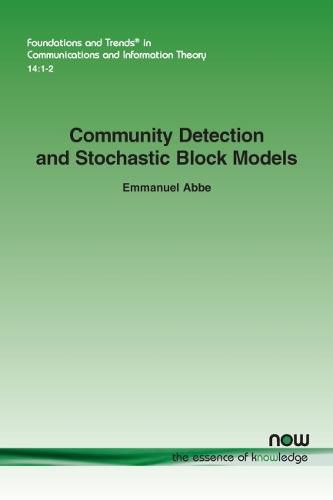Readings Newsletter
Become a Readings Member to make your shopping experience even easier.
Sign in or sign up for free!
You’re not far away from qualifying for FREE standard shipping within Australia
You’ve qualified for FREE standard shipping within Australia
The cart is loading…






This title is printed to order. This book may have been self-published. If so, we cannot guarantee the quality of the content. In the main most books will have gone through the editing process however some may not. We therefore suggest that you be aware of this before ordering this book. If in doubt check either the author or publisher’s details as we are unable to accept any returns unless they are faulty. Please contact us if you have any questions.
The field of community detection has been expanding greatly since the 1980s, with a remarkable diversity of models and algorithms developed in different communities like machine learning, computer science, network science, social science, and statistical physics. Various fundamental questions remain nonetheless unsettled, such as: are there really communities? Algorithms may output community structures, but are these meaningful or artefacts? Can we always extract the communities when they are present; fully, partially? And what is a good benchmark to measure the performance of algorithms, and how good are the current algorithms?
This monograph describes recent developments aiming at answering these questions in the context of block models. Addressing the issues from an information-theoretic view-point, the author gives a comprehensive description of the historical and recent work that has led to key new concepts in the various recovery requirements for community detection. The monograph provides a compact introduction to community detection, which enables the reader to apply these techniques in applications such as understanding sociological behavior, protein to protein interactions; gene expressions; recommendation systems; medical prognosis; DNA 3D folding; image segmentation, natural language processing, product-customer segmentation, webpage sorting, and many more.
$9.00 standard shipping within Australia
FREE standard shipping within Australia for orders over $100.00
Express & International shipping calculated at checkout
This title is printed to order. This book may have been self-published. If so, we cannot guarantee the quality of the content. In the main most books will have gone through the editing process however some may not. We therefore suggest that you be aware of this before ordering this book. If in doubt check either the author or publisher’s details as we are unable to accept any returns unless they are faulty. Please contact us if you have any questions.
The field of community detection has been expanding greatly since the 1980s, with a remarkable diversity of models and algorithms developed in different communities like machine learning, computer science, network science, social science, and statistical physics. Various fundamental questions remain nonetheless unsettled, such as: are there really communities? Algorithms may output community structures, but are these meaningful or artefacts? Can we always extract the communities when they are present; fully, partially? And what is a good benchmark to measure the performance of algorithms, and how good are the current algorithms?
This monograph describes recent developments aiming at answering these questions in the context of block models. Addressing the issues from an information-theoretic view-point, the author gives a comprehensive description of the historical and recent work that has led to key new concepts in the various recovery requirements for community detection. The monograph provides a compact introduction to community detection, which enables the reader to apply these techniques in applications such as understanding sociological behavior, protein to protein interactions; gene expressions; recommendation systems; medical prognosis; DNA 3D folding; image segmentation, natural language processing, product-customer segmentation, webpage sorting, and many more.